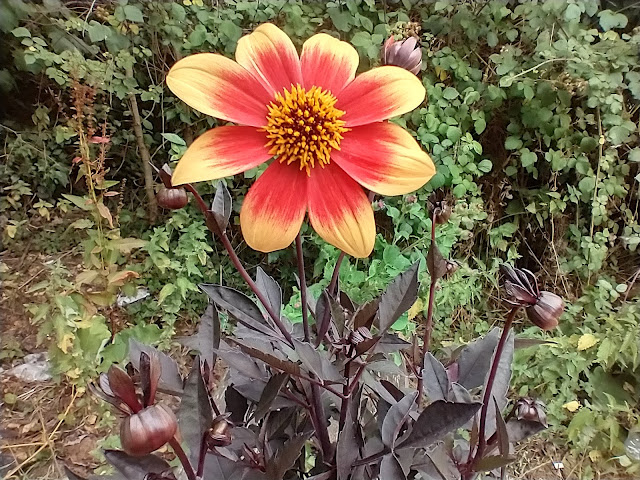In and Out the Spanish Bluebells
 |
| Spot the difference: English bluebell to the left and Spanish on the right |
One of the surprise finds on my daily walk this month are the ribbons of English bluebells threading their way through the remains of the old hedgerows on our estate. They're a joy to behold and I'd say we're currently at peak bluebell in this corner of the world.
Their presence has spurred me on to grub out the remaining Spanish bluebells I accidentally planted a few years ago. The packet was labelled as English, but as you can see from the above picture on the right they're clearly not.
My friend Helen posted on her Facebook page a few days ago urging her friends to take out any Spanish bluebells they find. Most people agreed, but someone said "Why? They're pretty!"
She has a point, though I'd say the delicacy of the English ones makes them much more beautiful, especially when viewed en masse in an ancient wood. Their heavenly scent and resemblance to a lake amongst the trees makes them one of the best sights of spring.
The gummy sap from English bluebells was used to fletch arrows in the bronze age and later to bind the pages of books together. Starch extracted from the bulb was used to stiffen collars and cuffs in Elizabethan times. Its potential for medicinal use is being investigated, particularly for the treatment of HIV and cancer.
Both bluebells are great for insects, particularly bees and it's this which is proving to be the downfall of the English bluebell as the two species can freely hybridise. Bees can roam for a mile or more in search of nectar, so there is the potential for quite separate populations of the two types to hybridise.
The hybrid is even more vigorous than its Spanish parent and a survey conducted by Plantlife in 2003 showed one in six broadleaved woodlands contained either the Spanish bluebell or the hybrid. As Britain has half the world's population of English bluebells, this is a cause for concern.
So today's task is to grub out my Spanish bluebells to give English ones at the top of the hill a fighting chance of survival. The accepted advice is to dig deep and remove all the bulbs. I've found stomping all over the leaves can be just as effective, presumably because this prevents the bulbs from replenishing their stores. It's easier and quite satisfying to do.
If you're not sure which bluebells you have in your neck of the woods, Sheffield and Rotherham Wildlife Trust has a very good pictorial and descriptive guide. The Woodland Trust website also has lots information.










Having got down and close, and discovering that I only have three natives left, I've also decided this is the year to get them out. I'm going for the dig approach as I'm worried that, as bluebells also multiply from bulbs, simply disconnecting the foliage won't stop "new" bulbs from producing plants next year. Then, after a second check next year, I'll replant natives "in the green" after the flowering season and hope for an all-native display the year after. And then I'll copiously dead-head!
ReplyDeleteYou're right John, there are bulbils that will produce plants next year and I'll employ the same method when they appear. I can't get in to dig them out because of the hedgerow next to the house which is full of blackthorn and hawthorn!
DeleteIt's a never ending battle isn't it, I pull the flowers and leaves off as soon as they appear. I feel I'm fighting a losing battle as my neighbours all have Spanish bluebells, it's a pity we can't train our bees!
ReplyDeleteThere's a little glimmer of hope Pauline. Some years the flowers of each bloom at different times depending on what the weather's been doing. It won't stop the relentless march of the bulbs, but at least hybridisation doesn't happen in those years and it means the English bluebell gets to multiply in peace.
DeleteI've put this task off- but this year the non natives have really taken off, and the native bluebells are swamped. Even the leaves of the Spanish ones are bigger and lusher than the natives. There will be much cursing. They are right under a very thorny holly and blackthorn hedge.
ReplyDeleteSame here Karen, but Helen's post on Facebook has galvanised me into action. I'm also grateful to the person who asked why... it gave me the chance of finding out more about what we stand to lose. It sounds like the stomping technique might be a good option for you too!
DeleteI have a lot of Spanish bluebells in my garden. They were planted - in red, white and blue - to mark the Queen's coronation. Knowing this history makes me a bit reluctant to tackle them, even though I'm no royalist. At the same time, I have English bluebells popping up on the other side of the house, which is both surprising and very pleasing.
ReplyDeleteThat's interesting Rachel, I would have thought the 2 populations would have mingled by now. Do they bloom at different times?
DeleteI've been digging up the dreaded Spanish for the last few years and it's one hell of a job. Those bulbs go down so deep. Persistence pays off but I've still got a long way to go.
ReplyDeleteThey sure do Jessica, which is one of the reasons I've gone for the leaf stomping approach. I have heavy clay so it's almost impossible to get them all out. It may take a year or two longer for the same effect as digging, but as you say persistence pays off :)
Delete